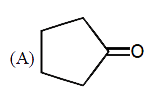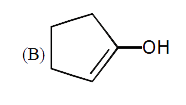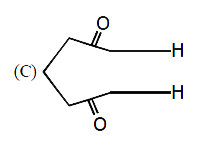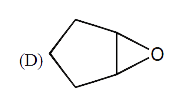Explore topic-wise InterviewSolutions in .
This section includes InterviewSolutions, each offering curated multiple-choice questions to sharpen your knowledge and support exam preparation. Choose a topic below to get started.
| 17551. |
Write the balanced equation for the reaction of aluminium carbide with water. |
| Answer» Solution :`underset("Aluminium CARBIDE")(Al_(4)C_(3))+""12H_(2)O""rarr underset("Aluminimum hydroxide")(4AL(OH)_(3))+""underset("Methane")(3CH_(4))` | |
| 17552. |
Write the main reason for the stability of colloidal sol. |
| Answer» SOLUTION :The main reason for STABILITY of colloidal SOL is that all colloidal PARTICLES in the sol carry the same charge. Hence, they REPEL each other and cannot coagulate. | |
| 17553. |
Which of the following is not correct regarding terylene |
|
Answer» STEP GROWTH POLYMER |
|
| 17554. |
The tripeptide is written as Glycine - Alanine - Glycine. The correct structure of the tripeptide is |
|
Answer»

|
|
| 17555. |
Write the reducing agents which reduce alkyl cyanides to primary amines. |
| Answer» SOLUTION :`(I ) LiAIH_4 (ii) H_2 //PT orNi "CATALYST "(iii) Na//C_2 H_5 OH` | |
| 17556. |
Which of the following statementsis not true ? |
|
Answer» HOCl is a stronger acid than `HOBr` Acidic nature `prop (1)/("Bond dissociation energy")` So, HF is not a stronger acid than HCl. |
|
| 17558. |
Which is not pi-bonded complex? |
|
Answer» Zeisc's salt |
|
| 17559. |
When an electric current is passed through a cell having an electrolyte, then the cations and anions move to their respective electrodes if the cathode is pulled out of the solution then |
|
Answer» Both CATIONS and anions will MOVE TOWARDS anode |
|
| 17560. |
Which of the following order of stability of complex ion is Incorrect ? |
|
Answer» `[Fe(C_2 O_4)_3]^(3-) lt [Fe(H_2 O)_6]^(3+)` `[Co(NH_3)_5 Cl]Cl_2 overset(AgNO_3)to ` 2 mole of AgCl `[Co(NH_3)_4 Cl_2] Cl overset(AgNO_3)to ` 1 mole of AgCl Complexes are respectively `[Co(NH_3)_6 Cl_3,[Co(NH_3)_5 Cl]Cl_2 and [Co(NH_3)_4 Cl_2]Cl` |
|
| 17561. |
Zinc metal is refined by: |
|
Answer» Crystallisation |
|
| 17562. |
Thymine is present in RNA but not in DNA.SAY TRUE/FALSE |
|
Answer» |
|
| 17563. |
Which of the following has Frenkel defects? |
|
Answer» SODIUM chloride |
|
| 17564. |
Which alloy is generally used inmaking bullets, shells and lighter flints? What is its composition ? With which other element it is generally alloyed and why ? |
| Answer» SOLUTION :The alloy used in KNOWN as MISCHMETAL. For details REFER to art. | |
| 17565. |
Which of the following combinations can be used to synthesise ethanol? |
|
Answer» `CH_(3)Mgl` and `CH_(3)COCH_(3)` 
|
|
| 17566. |
Which of the following statementsis correct ? |
|
Answer» OXIDATION number of oxygen in `K_(2)O` is + 1 (d) `Zn |ZnSO_(4)` is not reference electrode . |
|
| 17567. |
Which oxides is colourless and neutral |
|
Answer» `N_(2)O` `N_(2)O_(3),N_(2)O_(4)` and `N_(2)O_(5) rArr ` ACIDIC |
|
| 17568. |
Which of the following is(are) alloy(s) not containing copper? |
|
Answer» BELL METAL |
|
| 17569. |
What may be the stable oxidation state of the transition element with the following d-electron configuration in the ground state of their atoms 3d^3, 3d^5, 3d^8, and 3d^4 ? |
|
Answer» SOLUTION :STABLE OXIDATION states: `3d^3 ` : Chormium `(3d^3 4s^2)` : oxidation states +2, +3, + 4 and +5 `3d^5` : Manganese `(3d^5 4s^1)` : oxidation states +3, + 4, and +6. `3d^5` : Manganese `(3d^5 4s^2)`: oxidation states (+2, + 4, + 6, + 7). `3d^8` : Cobalt `(3d^7 4s^2)`: oxidation states + 2, + 3 (in complexes) (Co BELONGS to 9 group) `3d^4` : such configuration does not exist in ground state . |
|
| 17570. |
Which polymer is used in the manufacture by reacting it with |
|
Answer» Polypropene |
|
| 17571. |
Which is the addition polymer |
|
Answer» Nylon-66 |
|
| 17572. |
Which factor is not effective in a reversible chemical reaction ?] |
|
Answer» Temperature |
|
| 17573. |
Which of the following reactions will not give propane |
|
Answer» `CH_3CH_2CH_2Clunderset(H_2O)overset"Mg/ether"to ` 
|
|
| 17574. |
What is the byproduct obtained in the Serpeck's process ? |
|
Answer» Oxygen |
|
| 17575. |
The strongest base from the following species is |
|
Answer» `NH^(2-)` |
|
| 17576. |
Which of the following is a minor tranquilizer? |
|
Answer» HALOPERIDOL |
|
| 17577. |
Which of the following reactions is an example of Wurtz reaction ? |
|
Answer» `RX+H_(2)OVERSET(NI,Al)rarrRH+HX` |
|
| 17578. |
Which of the following are examples of fibrous proteins ? |
| Answer» Solution :Albumin | |
| 17579. |
Under identical conditions of temperature the density of a gas A is three times that of gas B while molecular mass of gas B while molecular mass of gas B is twice that of A. The ratio of pressure of A and B will be : |
|
Answer» 6 |
|
| 17580. |
Whichof the followingis an aldohexose ? |
|
Answer» Sucrose |
|
| 17582. |
The volume of 0.1 M NaOH solution required to neutralise the solution produced by dissolving 1.1 g of P_4 O_6 in water is Y xx 100 . What is the value of Y ? |
|
Answer» Solution :`P_(4)O_(6)+6H_(2)O RARR 4H_(3)PO_3` `(1.1gm)/(220)5xx10^3molrarr4xx5xx10^(-3)mol=2xx10^(-2)` mol `H_(3)PO_(3)+2NaOHrarrNa_(2)HPO_3+2H_(2)O` `2 xx 10 - 2mol 2 xx 2 xx 10^(-2) mol :. " moles of "NaOH = 4 xx10^(-2)=M_(NaOH)xxV_(LN2)` `impliesV=(4xx10^(-2))/(M_(NaOH))=(4xx10^(-2))/(0.1)=0.4 ` LITER `implies V=400 ml = 4 xx 100 implies Y = 4` |
|
| 17583. |
What amount ofCaO will be produced by 1 g of calcium ? |
|
Answer» Solution : `Ca to CaO` APPLYING POAC for Ca atoms as Ca atomsare conserved, MOLES of Ca atomsin the reactant - moles of Ca atoms in the product = moles of Ca atomsin Ca O `= 1 xx`moles of CaO (`:.` 1 mole of CaO contains 1 mole of Ca atoms ) `("wt. of Ca")/(UNDERSET("(Rule 2)")("at. wt. of Ca"))=("wt. of CaO")/(underset("(Rule 1)")("mol. wt. of CaO"))` `(1)/(40) = (wt.ofCaO)/(56), wt . of CaO = (56)/(40) = 1.4 g` |
|
| 17584. |
What is the action of ammonia [NH_(3)] on benzoic acid? Write equation. |
Answer» Solution :BENZOIC acid reacts with AMMONIA to give ammonium benzoate. On further HEATING gives BENZAMIDE. 
|
|
| 17585. |
Urea is converted into ammonia and carbon dioxide by the enzyme: |
|
Answer» diastase |
|
| 17586. |
Which of the following is used in the estimation of carbon monoxide? |
|
Answer» `ClO_2` |
|
| 17587. |
What is the effect ofpressure on the boilling point of a liquid ? |
| Answer» SOLUTION :Boiling POINT of a liquid INCREASES with increases of PRESSURE . | |
| 17588. |
Which of the following statement is true in the context of photoelectic effect? |
|
Answer» The kinetic energy of EJECTED electron is independent of the intensity of a radiation. `V_(0)=h/e v-h/e v_(0), slope_(1)=h/e` Similarly, `hv=hv_(0)+K_(max)` or `K_(max)=hv-hv_(0),` `"SLOPE"_(2)=h ("slope"_(2))/("slope"_(1))=h/(h//e)=e` |
|
| 17589. |
Which of the following is not a consequence of green house effect |
|
Answer» Climatic CONDITIONS will be changed resulting in increase in temperature |
|
| 17590. |
Which of the following elements is a lanthanide (Rare-earth element) ? |
|
Answer» Cadmium |
|
| 17591. |
What is peptisation? Give an example. |
| Answer» Solution :(i) The dispersion of a precipitated material into colloidal solution by the action of an electrolyte in solution is termed as peptisation. (II) The electrolyte used is called a peptizing AGENT. Eg: SILVER chloride can be converted into a sol by ADDING hydrochloric acid. Precipitate `AgCl overset(HCl)(to)AgCl`COLLOID | |
| 17593. |
Write Kohlrausch law and give its importance (applications). |
|
Answer» Solution :* Law: The law states that limiting molar conductivity of an electrolyte can be represented as the SUM of the individual contributions of the anion and cation of the electrolyte. * USES :Using Kohlrausch law of independent MIGRATION of ions, it is possible to calculate `Lamda_(m)^(@)` for any electrolyte from the `lamda_(m)^(@)` of individual ions. `Lamda_(m)^(@)=(v_(+)lamda_(m^(+))^(@)+v_(-)lamda_(m^(-))^(@))` * Moreover, for weak electrolytes like acetic acid it is possible to determine the value of its dissociation constant once we know the `Lamda_(m)^(@) and Lamda_(m)` at a given CONCENTRATION c. * `kappa_(a)=(calpha^(2))/(1-ALPHA)=(cLamda_(m)^(2))/(Lamda_(m)^(@)(Lamda_(m)^(@)-Lamda_(m)))` * Degree of dissociation of weak electrolyte: `(alpha)=(Lamda_(m))/(Lamda_(m)^(@))`. |
|
| 17594. |
Which of the following is not characteristic of alcohols |
|
Answer» Lower ALCOHOLS are stronger and have bitter taste |
|
| 17595. |
Which among the following is not an antibiotic? |
|
Answer» Chloramphenicol |
|
| 17596. |
What are the factors which influence the adsorption of a gas on a solid? |
|
Answer» Solution :Factors affecting ADSORPTION of gases on solids are : (i) Surface AREA of ADSORBENT (ii) NATURE of ADSORBATE (iii) Effect of temperature (iv) Effect of pressure. |
|
| 17597. |
Which type of biomolecules have some structural similarity with synthetic polyamides ? What is this similarity? |
Answer» Solution :POLYAMIDES have STRUCTURAL REPEATATION of amide linkages which is similar to peptide BOND as present in polypeptide chains of proteins.
|
|
| 17598. |
Which of the following is a negatively charged bidentate ligand ? |
|
Answer» DIMETHYL glyoximato 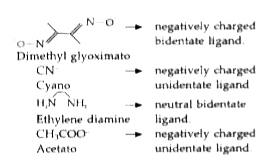
|
|
| 17599. |
The total number of valency for PO_4^(3-) ion is : |
|
Answer» 32 |
|
| 17600. |
What will be the chief productg from the following reaction sequence ? |
|
Answer»
|
|








